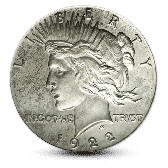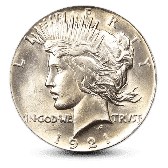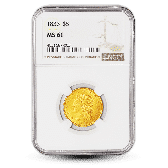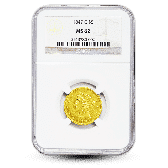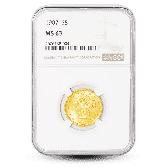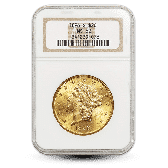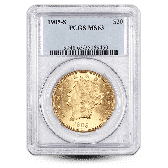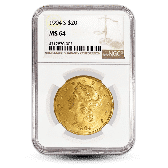History of the U.S. Mint
HISTORY OF THE U.S. MINT
The Rich Heritage Found in Our Nation’s Coinage
HISTORY
- RESOURCES
History
The U.S. Mint is charged with the production of circulating coinage for the United States to conduct trade and commerce, as well as controlling the movement of precious metals bullion.
The U.S. Mint was established with the passing of the Coinage Act on April 2, 1792. Congress chose the site of our country’s first Mint to be in Philadelphia, which was the nation’s capital at the time. Over time, several branch Mint facilities opened across the country to serve the needs of a growing country.
There are currently four active mints that produce coins: Denver, Philadelphia, San Francisco and West Point.
San Francisco, California
The San Francisco Mint was opened in 1854 to cater to the gold mines of the California Gold Rush. Within its first year of operation, this facility processed $4 million in gold into coinage.
Quickly outgrowing the original building, this branch moved into a new building in 1874. The new building, often referred to as “The Granite Lady”, is one of the few that survived the great San Francisco earthquake in 1906.
Mint Marks
Coins produced at the San Francisco Mint bear the mint mark “S”.
San Francisco Coins
Despite several interruptions in production, the San Francisco mint has produced over 9 billion coins since it first opened. Until the early eighties, these were coins meant primarily for circulation. Now on its third home, you’ll mostly find the San Francisco mint producing proof coins, as well as commemorative medals. In 2018 the San Francisco celebrated its 50th year by releasing a limited edition Silver Reverse Proof Set. These delicately frosted high-contrast coins are gorgeous to behold, and include 5 silver National Parks Quarters, a Native American $1 coin, a silver Kennedy Half Dollar, a silver Roosevelt Dime, a Jefferson Nickel and a Lincoln Cent.
Carson City, Nevada
The Carson City Mint was built in 1863, but wasn’t used for full operation until 1870. This branch ran until 1885, went on hiatus, and then resumed production in 1889 when it finally closed its doors permanently.
Conveniently built near a silver mine, the Carson City Mint produced 50 different issues of silver coins and 57 different issues of gold coins. Its primary purpose was to facilitate processing silver from the Comstock Lode.
Mint Marks
Coins produced at the Carson City Mint bear the mint mark “CC”. These coins, particularly Morgan Silver Dollars, are generally considered quite rare and tend to carry a higher premium among collectors and investors alike.
Carson City Coins
This Mint is no longer in active operation as the Comstock now produces very little silver. The building is now a museum. The best and most well-loved coin it’s known to have produced is the Morgan Silver Dollar. 2.8 million of these coins bear the CC mint mark. Some have attained an impressive status among collectors. For example, the 1879 CC Morgan Silver Dollar can sell for as much as $22,500 even at MS Grade 64.
Denver, Colorado
Initially a United States Assay Office authorized by an act of Congress in 1862, the Denver Mint first began coin production on February 1, 1906, though the site was purchased in 1896 for $60,000 and construction began in 1897.
During its first year, the Denver Mint produced 167 million coins. It is now the single largest producer of coins in the entire world.
Mint Marks
Coins produced at the Denver Mint bear the mint mark “D”.
Denver, CO Coins
In 1922 Gangsters robbed the Denver Mint, taking off with $200,000 in $5 bills. Today, security is tight, even if you’re just going for one of their 45-minute tours. Quite a bit of the pre-1933 gold coins we offer here on this site would have come from the Denver Mint. They were a large producer of Double Eagles, Quarter Eagles, and Half-Eagles prior to 1931. They also produced Buffalo Nickels.
Philadelphia, Pennsylvania
The U.S. Mint’s first facility was the Philadelphia Mint, built in 1792 and operating there until 1833. The second building saw construction begin in 1829 and would remain in use until 1901. The third building would produce coins from 1902-1969.
The Philadelphia Mint’s fourth and current building, mere blocks from the site of the original building, opened in 1969 and still operates today. It can produce an astounding 1 million coins per day.
Mint Marks
Uncirculated coins produced at the Philadelphia Mint bear the mint mark “P”, whereas circulated coins prior to 1980 carried no mint mark, with the exception of the Jefferson nickels minted from 1942-1945.
Philadelphia, PA Coins
Despite being America’s oldest mint, the Philadelphia facility continues to produce. It releases both circulating and uncirculating coin sets, as well as commemorative coins and medals. The mint keeps a team of sculptor-engravers on site whose sole job it is to create designs for the coins the mint produces.
It’s also possible to tour this mint. Visitors can still watch the very first coining press and view coin operations in progress.
New Orleans, Louisiana
The New Orleans Mint was one of three Mints established in 1835. It’s location was selected due to its location on the Mississippi River, which made it an ideal center for for commerce.
It produced over 427 million gold and silver coins from 1838-1861 and again from 1879 to 1909. It was considered the most important branch of the U.S. Mint until the San Francisco Mint began coinage production in the 1850s.
Mint Marks
Gold and silver coins produced at the New Orleans Mint bear the mintmark “O”. Coins bearing this mint mark are considered quite rare.
Charlotte, North Carolina
Few people know America’s first gold rush didn’t take place in the west. It took place in the east, in North Carolina in the late 1780s. Gold mines became the single largest employer in the Carolinas until the California Gold Rush in 1848. The Charlotte, NC mint was built in 1831 to take advantage of the local gold. Until then an unofficial, private mint was striking local gold that was still accepted in trade, proving the universal adage that gold is gold and will always have value.
Mint Marks
Coins struck in Charlotte bear a mint mark of “C.”
Charlotte, NC Coins
The Charlotte mint burnt down in 1844. It reopened 2 years later, but shut down again in 1861, when the Confederacy took over North Carolina. They did not choose to mint any Confederate coins there. Today the building serves as an art museum.
As a result of this short run, and of Franklin Roosevelt’s destruction of most pre-1933 coins, all Charlotte coins are exceptionally rare. One of the rarest is the “1949-C Open Wreath Gold Type 1 $1 coin.” There are only 5 of those that anyone knows of in the whole world. But many other “C” series coins hold great worth. An MS 66 1851-C Gold Dollar now sells for over $40,000.
Dahlonega, Georgia
Dahlonega, GA Coins
When it was running, the Dahlonega mint produced Gold Dollars, Quarter Eagles, Three Dollar gold pieces, and Half Eagles.
Since it was a small press to begin with, because it didn’t operate for very long, and because most gold coins got destroyed in 1933, there just are not very many “D” coins left. Less than 1% of this mint’s final product exists, and all are highly prized by collectors.


